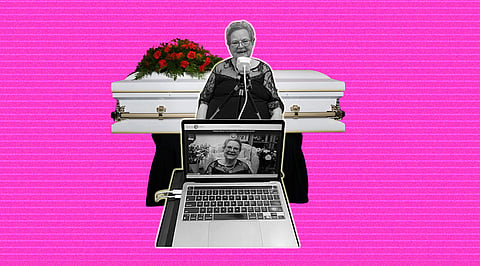

A few hundred years ago, humans did not have pictures to remember the dead. Moving images and videos came much later. When someone dies, they leave behind a lifetime of memories for their loved ones to grieve. Thanks to AI, it doesn't have to be the same anymore, as it appears that one could still talk to the deceased.
With the help of advanced artificial intelligence and expert psychological evaluation, it creates a digital clone that lets people talk to the dead with a video tool. And now, technology is promising more than just pictures or videos to remember loved dead ones. It is promising to help us interact with the dead long after they have passed away. While this new AI method of communicating with the dead is extremely impressive if not a little creepy.
Marina Smith MBE passed away at 87 in the UK. At her funeral, but appeared as a hologram, seeming to come alive. She was able to talk to the guests and answered their questions at her own funeral with an AI-powered 'holographic' video tool. The AI matched the questions from guests and played the correct clip.
Dr. Stephen Smith, the CEO, and co-founder of LA-based AI company StoryFile played his mother's videos on a screen at a funeral. He was one of the first to adopt this new technology that enabled her to make an appearance at her own funeral. The StoryFile system uses real pre-recorded responses to questions.
Smith said the hologram 'shocked' the mourners as it answered questions with new details and honesty. It looked like they were playing just a simple video of Smith, but actually, the digital avatar was also responding to questions asked by relatives at the funeral. StoryFile's efforts are representative of a much larger push by Silicon Valley to bring back the dead with the power of machine learning.
The company combines the latest studio technology with a bank of 20 synced cameras to capture the subject in Hologram-specific detail. StoryFile creates a digital clone of a person using 20 synchronized cameras and records them answering a range of questions. StoryFile was originally intended to preserve the stories of Holocaust survivors and other historical figures. Unlike 'deepfake, the StoryFile system can make a subject say things they didn't mean to, this StoryFile artificial intelligence technology allows people to have real-time conversations.
StoryFile isn't the only company working on bringing the dead back to life. Stephen says that the platform allows an individual to capture his legacy in a way that no one else has. She's not the only one to have been revived with the power of AI by StoryFile. The former Screen Actors Guild president Ed Asner was able to answer questions from attendees at his own funeral earlier.
Join our WhatsApp Channel to get the latest news, exclusives and videos on WhatsApp
_____________
Disclaimer: Analytics Insight does not provide financial advice or guidance. Also note that the cryptocurrencies mentioned/listed on the website could potentially be scams, i.e. designed to induce you to invest financial resources that may be lost forever and not be recoverable once investments are made. You are responsible for conducting your own research (DYOR) before making any investments. Read more here.
